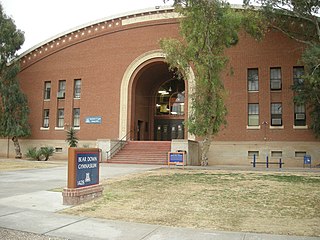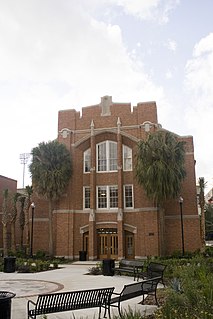
The University of Arizona is a public land-grant research university in Tucson, Arizona. Founded in 1885 by the 13th Arizona Territorial Legislature, the U of A was the first university in the Arizona Territory.

Memorial Gymnasium is a multi-purpose facility located in Nashville, Tennessee. Usually called Memorial Gym or simply Memorial, the building is located on the western end of the Vanderbilt University campus. It was built in 1952 and currently has a seating capacity of 14,326. It serves as home court for the school's men's and women's basketball programs.

The Walter A. Haas Jr. Pavilion is an indoor arena in the western United States, on the campus of the University of California in Berkeley, California. It is the home venue of the Golden Bears men's and women's basketball, women's volleyball, and men's and women's gymnastics teams. The arena is located in the middle of the main sports complex, overlooking Evans Diamond (baseball) and Edwards Stadium (track/soccer).

Welsh–Ryan Arena is a 7,039-seat multi-purpose arena in Evanston, Illinois, United States, near the campus of Northwestern University. It is home to four Northwestern Wildcats athletic teams: men's basketball, women's basketball, women's volleyball, and wrestling. It is located inside McGaw Memorial Hall, to the north of Ryan Field.

McKale Memorial Center is an athletic arena in the southwest United States, located on the campus of the University of Arizona in Tucson, Arizona. As the home of the university's Wildcats basketball team of the Pac-12 Conference, it is primarily used for basketball, but also has physical training and therapy facilities. Its construction is marked with a large copper cap that has oxidized brown. The arena opened 48 years ago in February 1973 and has an official capacity of 14,644 spectators. The elevation at street level is approximately 2,450 feet (750 m) above sea level.

"Bear Down" is the official motto of the University of Arizona, located in Tucson, Arizona. It is the inspiration for "Bear Down, Arizona!," the unofficial fight song of the school's Arizona Wildcats. The official fight song is "Fight! Wildcats! Fight!" written by Douglas Holsclaw.

The Arizona Wildcats are the athletic teams that represent the University of Arizona, located in Tucson. The Wildcats compete at the National Collegiate Athletic Association (NCAA) Division I level as a member of the Pac-12 Conference. Arizona's chief intercollegiate rival is the Arizona State Sun Devils, and the two universities' athletic departments compete against each other in multiple sports via the State Farm Territorial Cup Series.
James Fred "Pop" McKale was an American football and baseball player, coach of football, basketball, baseball, and track, and college athletics administrator. He is best known for his four-decade association with the University of Arizona. He served as athletic director at U of A from 1914 to 1957. He served as Arizona's head football coach from 1914 to 1930, compiling a record of 80–32–6. McKale was also the head basketball coach at Arizona from 1914 to 1921, tallying a mark of 49–12, and the head baseball coach at the school from 1915 to 1919 and again from 1922 to 1949, amassing a record of 304–118–7. McKale was inducted into the Arizona Sportsmen Hall of Fame in 1959 and was a charter member of the Arizona Sports Hall of Fame, inducted in 1976. The McKale Center, the University of Arizona's home basketball venue, was opened in 1973 and named in McKale's honor.

Dillon Gymnasium is an on-campus multi-purpose athletic facility on the campus of Princeton University in Princeton, New Jersey. It was built in 1947 to replace University Gymnasium, which had burned to the ground in 1944. It houses a 1,500-seat gymnasium, squash courts and a pool.

Kathryn Chicone Ustler Hall is a historic building on the campus of the University of Florida (UF) in Gainesville, Florida. It was designed by William Augustus Edwards in the Collegiate Gothic style and opened in 1919 as the University Gymnasium. In that capacity, the building was the first home of the Florida Gators men's basketball team, and it continued to serve as the home court for most of the university's indoor sports programs until the Florida Gymnasium opened in the late 1940s. The university became co-educational at about the same time, and the building was rechristened the Women's Gymnasium and was repurposed as a recreation center for the school's many new female students. On June 27, 1979, it was added to the U.S. National Register of Historic Places.
The University of Kentucky offers a variety of choices to students. The choices range from a number of dining options, residence halls, and athletic facilities to student organizations, religious groups, Greek-letter organizations, and intramural competitions/campus recreation.

The Florida Gymnasium is a historic building located on the campus of the University of Florida (UF) in Gainesville. It opened in 1949 as a 7,000-seat multi-purpose arena and served as the home court of the Florida Gators men's basketball team and other UF indoor sports programs for over thirty years, acquiring the nickname of "Alligator Alley" during that time.
Alumni Gymnasium, now known as Alumni Gym Fitness Center, is a building on the University of Kentucky (UK) campus in Lexington, Kentucky. It is located on the corner of South Limestone Street and Avenue of Champions next to the University of Kentucky Student Center. When it opened in 1924, replacing Alumni Hall, it was a 2,800 seat multi-purpose arena, serving as home to the UK Wildcats basketball team. It was replaced when the Memorial Coliseum opened in 1950. The building later became a student recreation facility, and was frequently used for recreational and intramural basketball. During this period, it was also home to the University of Kentucky Men's Club Basketball team, University of Kentucky Club Dodgeball team, and the UK Men's Club Volleyball team. The interior of the facility was gutted in 2017 as part of a project to renovate the university's student center, and the building reopened in 2018 as a student fitness center.

Memorial Gymnasium is a 2,500-seat multi-purpose arena in Charlottesville, Virginia. It opened in 1924. It replaced Fayerweather Gymnasium as home to the University of Virginia Cavaliers basketball team until University Hall opened in 1965.

The Arizona Wildcats men's basketball team is the intercollegiate men's basketball program representing the University of Arizona in Tucson, Arizona. They compete in the Pac-12 Conference of NCAA Division I and is currently coached by Tommy Lloyd.

Herron Gymnasium was a gymnasium and classroom building on the Miami University campus in Oxford, Ohio. Later known as Van Voorhis Hall, it was listed in the National Register of Historic Places in November 1979. Originally conceived in 1893, it was constructed in 1897 and named for John W. Herron, a Miami alumnus and Cincinnati judge. It was Miami University's first gymnasium, and would serve as the main recreational center until the construction of Withrow Court in 1932, which led Herron to become a women's gym. Except for an interlude during World War II when it served as a Navy barracks, it served as a women's gym until the construction of "New Herron" in 1962. In the late 20th century its use diminished to AFROTC and men's intramural sports, and the gymnasium was demolished in 1986 and replaced with a parking lot.

The University of Wisconsin Armory and Gymnasium, also called "the Red Gym", is a building on the campus of University of Wisconsin–Madison. It was originally used as a combination gymnasium and armory beginning in 1894. Designed in the Romanesque revival style, it resembles a red brick castle. It is situated on the shores of Lake Mendota, overlooking Library Mall, and adjacent to Memorial Union.

War Memorial Gymnasium is a 2,500-seat multi-purpose indoor arena in the northwest United States, on the campus of the University of Idaho in Moscow, Idaho. Opened 93 years ago in November 1928, the venue honors state residents who gave their lives in the service of their country in World War I.

Clinton Campbell (1865-1937) was a "locally prominent builder" who worked in Phoenix, Arizona. Several of his works both survive and are listed on the U.S. National Register of Historic Places. Campbell died in 1937 and was buried in Phoenix's Greenwood/Memory Lawn Mortuary & Cemetery.

The Safford High School building, which was located where Safford Middle School is currently located, opened to students on September 13, 1915. It was designed by Henry O. Jaastad. It served as the main high school building through the 1979–80 school year. Over the years other buildings were built. This included the WPA-built Baker Stadium, which served as the home of the Safford Bulldogs from 1938 through the 1986 season; a gymnasium in 1943, which allowed the previous gym to be retrofitted into an auditorium; and the other classroom buildings. This included a library built in the 1960s. It is noted that, during this period, the baseball stadium was at the old bleachers by Lafe Nelson School as was the field house for the football and wrestling teams.




















